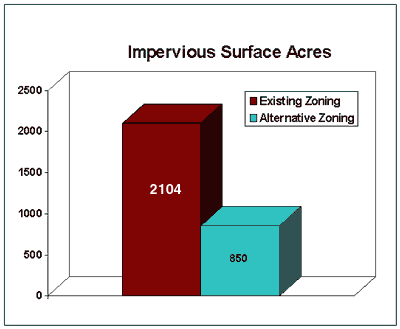
Amount of impervious surface (acres) under two zoning scenarios; haphazard (worst) and best-practises (best).
The amount of impervious surfaces was modelled under the two scenarios.
Whats the difference?
Fletcher's Folly under existing (traditional) zoning has more than twice the road, parking lot and rooftop surface area than the GOZ (alternative) zoning.
Why this difference?
In Fletcher's Folly, the traditional zoning results in decentralized development. In the alternative, development has been centralized and this allows many business and residential uses of the same infrastructure reducing the total impervious surface.
What will it mean?
Fletcher's Folly will have less water percolating into the soil and an increase in the amount of water running off into stream and rivers. At high enough level impervious surface can cause erosion of streambeds and stop the replenishment of underground aquifers. These high areas of impervious surface can cause environmental degradation and best management practices can be used to ameliorate some of these problems. The traditional zoning file will spread high levels of imperious surface across the entire watershed making it much harder and expensive to use best management practices.

